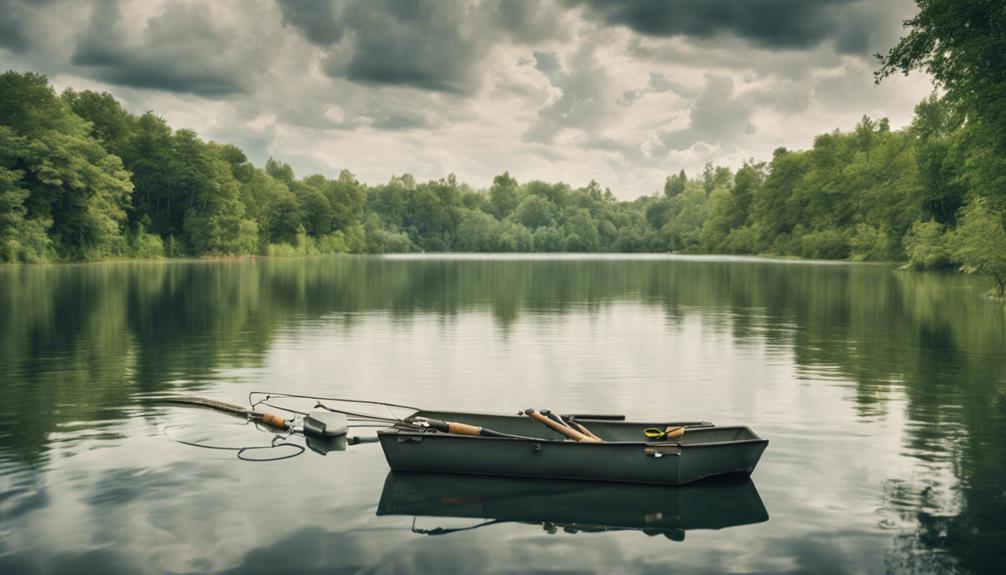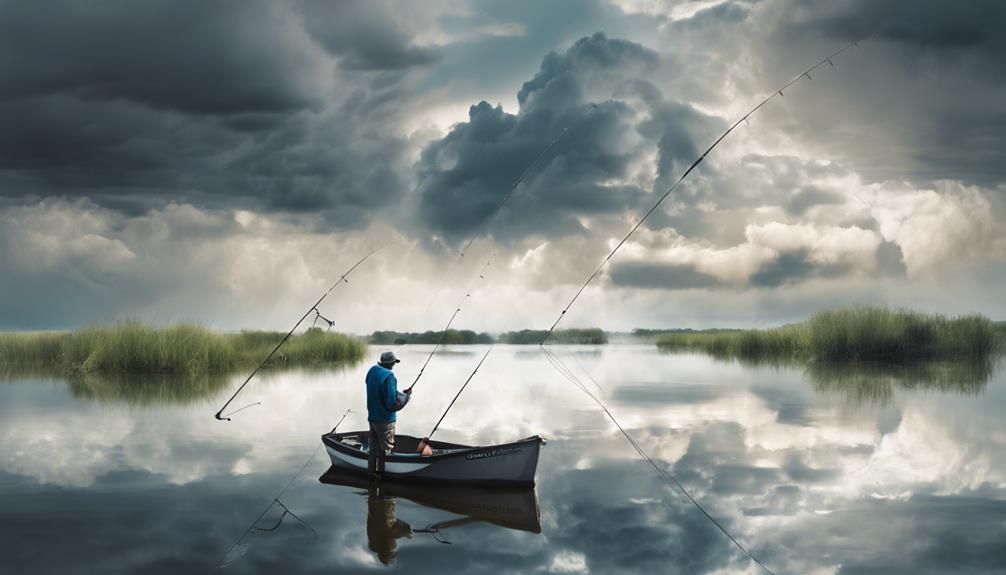Weather impacts fish species significantly. Temperature preferences influence spawning, metabolism, and growth. Barometric pressure affects feeding patterns and swimming abilities. Wind speed impacts fishing success and bait placement. Rainfall triggers hatches and affects feeding patterns. Cloud cover influences fish activity and behavior. Thunderstorms alter fish movement and behavior. Seasonal changes play a role in fish migration. Accurate weather forecasts are crucial for successful fishing expeditions. Understanding these factors is essential for managing fisheries effectively. Weather intricately shapes the behavior and well-being of fish species in aquatic environments.
Temperature Preferences of Fish
Fish species exhibit distinct temperature preferences that significantly influence their behavior and physiological functions. These preferences are crucial factors affecting the spawning habits and oxygen levels of various fish species. Temperature plays a vital role in determining the metabolic rate, growth, reproduction, and overall distribution of fish in aquatic environments.
Spawning habits of fish are intricately linked to temperature variations. Different species have specific temperature ranges within which they prefer to spawn. For example, cold-water fish such as trout often prefer cooler temperatures for successful spawning. Fluctuations in temperature can disrupt the spawning behavior of fish, impacting their reproductive success and overall population dynamics.
Moreover, oxygen levels in water are closely tied to temperature preferences of fish. Warmer water holds less oxygen than cooler water, which can be a critical factor for fish survival. Fish species that thrive in colder waters may struggle to obtain sufficient oxygen in warmer temperatures, leading to stress and potential population decline. Understanding the relationship between temperature, oxygen levels, and fish behavior is essential for effective fisheries management and conservation efforts.
Barometric Pressure and Fish Behavior
Exploring the influence of barometric pressure on fish behavior reveals intricate connections between atmospheric conditions and aquatic ecosystems. Barometric pressure, also known as atmospheric pressure, plays a crucial role in influencing fish feeding patterns and habitat preferences. Fish are highly sensitive to pressure changes, which can impact their swimming abilities, buoyancy control, and overall behavior.
When barometric pressure is high, fish tend to be more active and feed more aggressively. The increased pressure pushes down on the water's surface, causing fish to feel more comfortable and secure in their environment. On the other hand, during periods of low barometric pressure, fish may become lethargic and feed less. This is because the decreased pressure allows the water to expand, making fish feel bloated and less inclined to hunt for food.
Moreover, barometric pressure influences fish habitat selection. Species that prefer stable atmospheric conditions are more likely to inhabit deeper waters where pressure variations are less pronounced. In contrast, fish that are adapted to changing pressure levels may thrive in shallower areas where pressure changes are more frequent.
In essence, understanding the relationship between barometric pressure and fish behavior is essential for successful fishing expeditions. By monitoring pressure trends and adapting your fishing techniques accordingly, you can increase your chances of a fruitful catch.
Wind Speed and Its Effect on Fishing
The interplay between atmospheric conditions and fishing outcomes extends beyond barometric pressure to include the significant impact of wind speed on fishing success. Wind speed plays a crucial role in determining the effectiveness of fishing expeditions, influencing various aspects of the angling experience.
When facing windy conditions, selecting the appropriate tackle becomes essential. Heavy winds can increase the resistance faced by your line, making it challenging to maintain control over your bait or lure. To combat this, opt for heavier sinkers and lures with better wind resistance to ensure they reach the desired depth and location effectively.
Understanding wind patterns is equally crucial for maximizing your casting accuracy. Casting with the wind can help increase the distance and accuracy of your casts, while casting against the wind can prove to be more challenging. By observing the direction of the wind and adjusting your casting technique accordingly, you can enhance your chances of placing your bait or lure where the fish are actively feeding.
Rainfall and Fish Feeding Patterns
During periods of increased rainfall, fish feeding patterns undergo significant shifts, altering the dynamics of angling opportunities in aquatic ecosystems. The primary factor influenced by rainfall is water clarity. Rainfall can lead to increased turbidity in water bodies due to sediment runoff, reducing visibility for fish. As a result, fish that rely on sight to hunt for prey may struggle to feed effectively during these times. On the other hand, species that primarily use other senses, such as smell or lateral lines, to locate food may not be as affected by decreased water clarity.
Moreover, rainfall can trigger hatches of aquatic insects, creating abundant food sources for fish. These insects are an essential part of the diet for many fish species, attracting them to the surface or shallower waters. Anglers can take advantage of this by using imitative fly patterns to mimic the insects and increase their chances of a successful catch. Additionally, the increased flow and oxygenation caused by rainfall can stimulate fish activity, making them more active and responsive to bait or lures.
Understanding how rainfall influences fish feeding patterns is crucial for anglers seeking to maximize their fishing success. By considering factors such as water clarity and the availability of aquatic insects, anglers can adapt their strategies to suit the prevailing conditions and increase their chances of a rewarding fishing experience.
Cloud Cover and Fish Activity
Cloud cover significantly impacts fish activity levels in aquatic environments, influencing their feeding behavior and movement patterns. When considering how cloud cover affects fish activity, several key factors come into play:
- Moon Phases and Fish Feeding Habits: The presence or absence of clouds can have a direct impact on moonlight penetration into the water. During full moon phases, increased moonlight can enhance fish feeding habits by providing better visibility for hunting prey. However, when cloud cover obscures the moon, fish may become less active due to reduced visibility. This fluctuation in light availability can significantly influence the feeding behavior of various fish species.
- Tidal Currents and Fish Behavior: Cloud cover can also affect tidal currents, which play a crucial role in fish behavior. Tidal movements are influenced by the gravitational forces of the moon and the sun. Cloud cover can impact these tidal currents by altering water temperatures and oxygen levels. Changes in tidal currents can lead to variations in water flow patterns, affecting how fish navigate their environment and seek food. Fish may adjust their behavior in response to these shifts in tidal currents caused by changes in cloud cover.
- Overall Activity Levels: In general, fish tend to be more active under cloudy conditions compared to bright, sunny days. Cloud cover can provide fish with a sense of security and cover, encouraging them to venture out and explore their surroundings more freely. This increased activity can lead to higher feeding rates and enhanced movement patterns as fish take advantage of the camouflage offered by cloudy skies.
Thunderstorms and Fish Movement
Amidst atmospheric disturbances, thunderstorms exert a profound influence on the movement patterns of fish in aquatic ecosystems. When lightning strikes the water's surface during a thunderstorm, it can startle fish, triggering a response that alters their behavior. Some species may seek shelter in deeper waters or under submerged structures to avoid the electrifying effects of lightning. This sudden burst of activity can lead to changes in the distribution of fish within the water column as they navigate the turbulent conditions brought on by the storm.
Moreover, water clarity plays a crucial role in how fish respond to thunderstorms. The heavy rainfall accompanying these storms can muddy the water, reducing visibility. In murky conditions, fish may rely more on their lateral lines and other sensory systems to navigate and locate prey, influencing their movements. Species that are visual predators may find it challenging to hunt effectively in such conditions, leading them to adjust their movement patterns in search of clearer waters.
Seasonal Changes and Fish Migration

Seasonal changes prompt significant shifts in fish migration patterns as they respond to variations in water temperature and food availability. Fish species exhibit various behaviors during different seasons to adapt to these environmental changes. Here are three key factors influencing fish migration during seasonal transitions:
- Spawning Behaviors: One crucial aspect of fish migration during seasonal changes is their spawning behavior. Many fish species migrate to specific areas to spawn, seeking out optimal conditions for their offspring to thrive. For instance, salmon undertake long and arduous journeys upstream to reach their spawning grounds, where they release their eggs and milt into the water.
- Water Temperature: Fish are highly sensitive to changes in water temperature, which often act as a trigger for migration. As temperatures fluctuate with the seasons, fish may migrate to seek out more favorable thermal conditions. Warmer waters can stimulate feeding behaviors, prompting fish to move to different locations in search of abundant food sources.
- Food Availability: Seasonal changes also impact the availability of food sources for fish. Some species migrate to follow their prey, which may exhibit seasonal movements of their own. By relocating to areas with higher food abundance, fish can ensure their survival and reproductive success.
Understanding how seasonal changes influence fish migration is essential for effective fisheries management and conservation efforts. By considering these factors, researchers and resource managers can better predict and protect critical habitats for migratory fish species.
Weather Forecasts for Successful Fishing
Effective fishing outcomes are significantly influenced by accurate weather forecasts, providing crucial insights into optimal conditions for successful fishing expeditions. When planning your fishing trip, consider checking tidal currents as they play a vital role in determining fishing success. Tidal currents influence the movement and behavior of fish, affecting their feeding patterns and locations. By understanding how tidal currents operate in the area you intend to fish, you can position yourself strategically to increase your chances of a successful catch.
Another essential factor to consider is the moon phases, as they impact fishing activity. Fish behavior often aligns with the lunar cycle, with certain phases triggering feeding frenzies while others result in reduced activity. For example, during full and new moon phases, fish tend to be more active, making these times ideal for fishing. Conversely, during quarter moons, fish may be less active, requiring different techniques to lure them successfully.
Frequently Asked Questions
How Does Humidity Affect Fish Behavior?
Humidity plays a crucial role in fish behavior. It impacts their ability to regulate body temperature, influencing spawning behaviors.
High humidity levels can lead to decreased oxygen levels in water, affecting fish feeding patterns and overall activity. Conversely, low humidity may promote increased oxygen levels but can also result in dehydration for some species.
Understanding how humidity interacts with these factors is essential for comprehending the intricate relationship between weather conditions and fish species.
Can Solar Radiation Impact Fish Feeding Habits?
When it comes to solar radiation and its impact on fish feeding habits, consider how temperature variations influence feeding patterns. Changes in weather can directly affect fish foraging behavior, potentially altering their feeding routines.
Solar radiation plays a crucial role in regulating water temperatures, which in turn can influence the availability of food sources for fish. Understanding these interactions is essential for comprehending the intricate relationship between weather conditions and fish feeding habits.
Do Lunar Phases Influence Fish Migration Patterns?
When considering fish migration patterns, the influence of lunar phases can't be overlooked. Moon phases play a pivotal role in the timing and direction of fish movements. The gravitational pull of the moon affects tides, which in turn impact fish behavior.
During full moons, fish may migrate more actively, while new moons could see a decrease in movement. Understanding these lunar influences is crucial for comprehending the complex dynamics of fish migration patterns.
What Role Does Water Clarity Play in Fish Activity?
Water clarity significantly influences fish activity. Clear water allows for better visibility, aiding in hunting prey and avoiding predators. In murky conditions, the ability to locate food decreases, impacting feeding behavior.
Furthermore, predator presence can alter fish movement patterns in response to potential threats. Water temperature also plays a role, affecting metabolism and energy levels, further shaping fish activity.
Understanding these factors is crucial for assessing the dynamics of fish species in their environment.
Are Fish More Active During Sunrise or Sunset?
During sunrise or sunset, fish activity can be influenced by tide changes and temperature variations. These factors play a crucial role in determining when fish are more active.
Tidal fluctuations can affect the movement of prey, impacting fish feeding patterns. Additionally, temperature changes during sunrise and sunset can stimulate fish metabolism, leading to increased activity levels.
Understanding these influences can help anglers strategically plan their fishing trips for optimal success.
Conclusion
In conclusion, weather plays a crucial role in influencing the behavior and activity of fish species. Factors such as temperature, barometric pressure, wind speed, rainfall, cloud cover, and seasonal changes all have a direct impact on fish movement, feeding patterns, and migration.
By understanding how weather conditions affect fish, anglers can better predict fish behavior and improve their chances of a successful fishing expedition.



